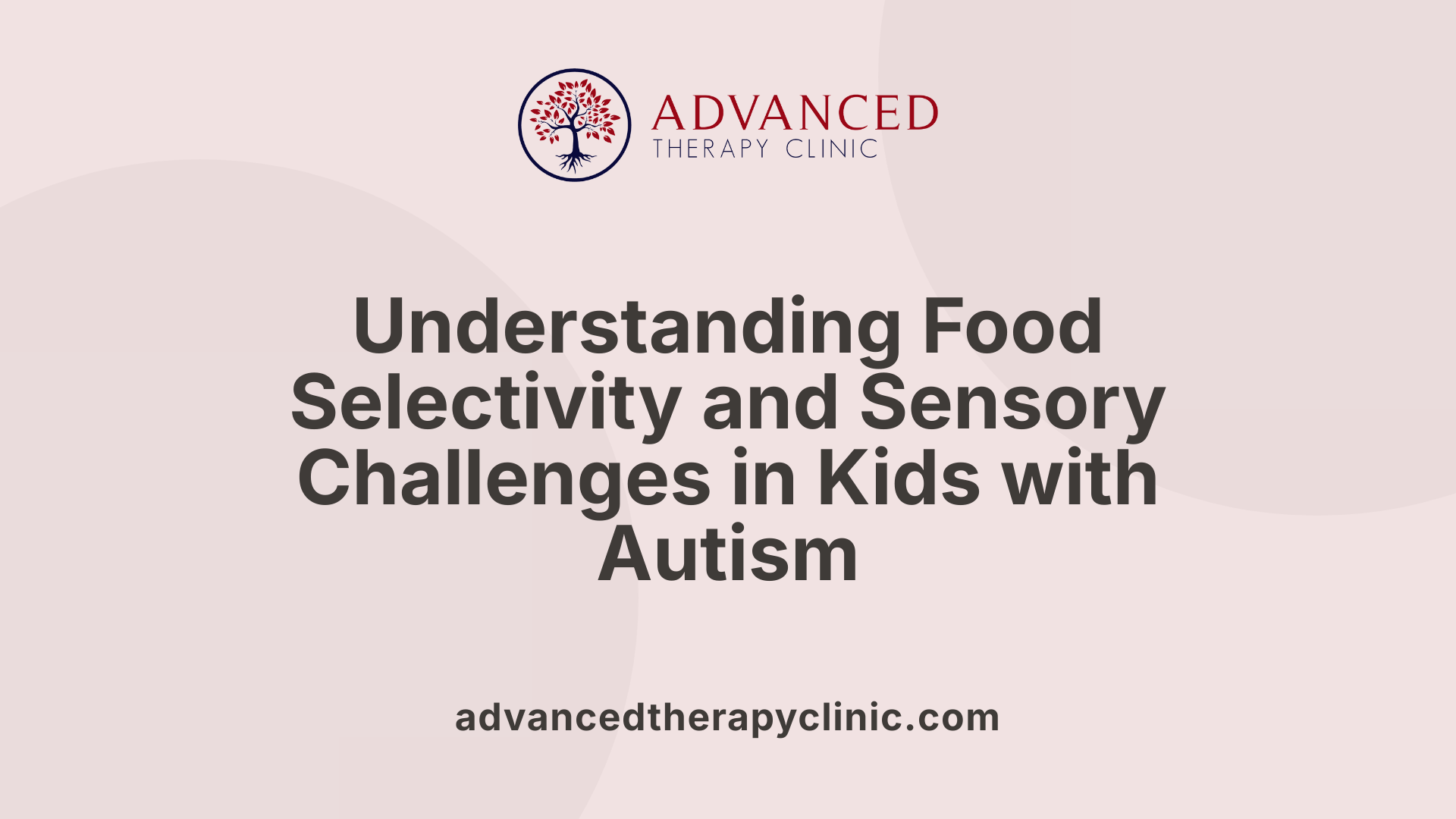Dairy And Autism


Understanding the Nutritional Landscape in Autism Spectrum Disorders
Autism Spectrum Disorders (ASD) encompass complex neurodevelopmental challenges accompanied by distinct dietary behaviors that influence overall health and development. Among these, dairy consumption and its effects have been a focal point in understanding ASD-related feeding issues and nutritional management. This article delves into the intersections of dairy intake, dietary preferences, metabolic factors, and therapeutic interventions, aiming to clarify their roles in the lives of children with autism and guide better clinical and family practices.
Eating Behaviors and Food Selectivity in Children with Autism

How common is food selectivity in children with autism spectrum disorder?
Food selectivity is highly prevalent in children with autism spectrum disorder (ASD), with studies indicating that 60-80% of autistic children exhibit limited diets. These children often restrict their intake to just a few preferred foods, which contributes to nutritional imbalances.
What types of foods do children with ASD tend to prefer?
Children with ASD commonly prefer energy-dense but low-nutrient foods, such as junk food. Their choices tend to include foods high in calories but low in vitamins, minerals, and essential fatty acids. This preference poses challenges for maintaining balanced nutrition and may contribute to metabolic and health issues over time.
How does sensory hypersensitivity affect food choices in children with ASD?
Sensory hypersensitivity plays a significant role in food rejection among children with ASD. Many of these children show aversions to particular food textures, colors, and temperatures, making it difficult to introduce new or healthy foods. This sensitivity often leads to picky eating habits and increased food selectivity.
The combination of high food selectivity rates, preferences for energy-dense low-nutrition foods, and sensory sensitivities complicates efforts to establish healthy meal routines. Addressing these challenges requires tailored behavioral and nutritional interventions to improve dietary variety and overall health for children with ASD.
The Impact of Dairy and Casein in Autism Diets

What Are Casein-Free Diets?
Casein-free diets eliminate the consumption of casein, a protein found in dairy products. Often paired with gluten-free diets, these dietary models are collectively called gluten-free/casein-free (GFCF) diets. They have gained attention as potential interventions to alleviate gastrointestinal and behavioral symptoms in children with autism spectrum disorders (ASD).
How Do Gluten-Free/Casein-Free Diets Aim to Help?
Research suggests that some children with ASD may experience gastrointestinal issues exacerbated by gluten and casein. Removing these proteins may help reduce symptoms such as abdominal pain, diarrhea, or constipation. Additionally, proponents claim behavioral improvements, such as reduced irritability and better social interactions, can result from these diets.
What Evidence Exists About Their Effectiveness?
Numerous studies have explored the impact of GFCF diets on autism symptoms, but results vary among individuals. While some families report improvements in both gastrointestinal comfort and behavior, clinical trials yield mixed outcomes. This variability may be due to factors such as differences in metabolism, gut microbiota composition, and individual sensitivity to dairy proteins.
Potential Mechanisms Behind Symptom Improvements
The removal of dairy and casein might reduce inflammation and heal a "leaky gut," which is hypothesized in some children with ASD to influence behavior through the gut–brain axis. By reducing intestinal permeability, the diet may also decrease exposure to peptides that could interfere with brain function.
Considerations for Implementation
Given that children with ASD often have selective eating habits, removing dairy can be challenging and might risk nutritional deficiencies if not carefully managed. Healthcare providers typically recommend involving nutritionists to ensure balanced intake when adopting these dietary models.
Overall, casein-free and gluten-free/casein-free diets represent promising but not universally effective strategies for managing ASD-related symptoms, particularly gastrointestinal and behavioral issues linked to dairy consumption.
Nutritional Deficiencies From Selective Eating Patterns

What vitamin and mineral deficiencies are common in children with ASD?
Children with autism spectrum disorder (ASD) often show high rates of food selectivity, with 60-80% having diets limited to a few preferred foods. This selectivity frequently leads to deficiencies in essential vitamins and minerals. Commonly deficient nutrients include vitamins such as A, D, B vitamins (including folinic acid), and minerals like zinc and magnesium, all crucial for healthy growth and neurological development.
How do these deficiencies impact metabolic functioning and development?
Low levels of these nutrients can impair metabolic functioning in children with ASD, affecting mitochondrial activity and biochemical pathways essential for brain function and physical health. Deficiencies may exacerbate symptoms like hyperactivity, tantrums, and language impairments. Additionally, inadequate nutrient intake can hinder overall development, making it more difficult for children to achieve optimal cognitive and behavioral outcomes.
What role do omega-3 fatty acids and other key nutrients play?
Omega-3 fatty acids are vital for brain development and function. Many children with ASD have low levels of omega-3s, which can compound neurological symptoms. Supplementation with omega-3s, along with vitamins and minerals, has shown promise in reducing behavioral issues and supporting metabolic health, although study results vary due to small sample sizes. Overall, ensuring adequate intake of these key nutrients is critical for managing ASD symptoms and supporting physical growth.
Tailored nutritional education and behavioral interventions are necessary to expand dietary variety in ASD children. Addressing food selectivity through structured family mealtime routines and interdisciplinary care can mitigate nutritional deficiencies and improve quality of life.
Gastrointestinal Issues and Their Role in Dairy Sensitivity

What gut microbiota imbalances and intestinal dysbiosis are common in children with ASD?
Children with autism spectrum disorder (ASD) often exhibit differences in gut microbiota composition compared to neurotypical peers. This imbalance, known as intestinal dysbiosis, disrupts the natural bacterial environment necessary for healthy digestion and immune function. Dysbiosis can impair gut barrier integrity and lead to increased intestinal permeability, commonly referred to as 'leaky gut'.
Is there a possible link to gluten sensitivity and 'leaky gut' phenomena?
Studies suggest a connection between gluten sensitivity and increased intestinal permeability in children with ASD. The 'leaky gut' condition may allow certain food proteins like gluten and dairy components to cross the intestinal barrier, triggering immune reactions and exacerbating gastrointestinal and behavioral symptoms. While this association is promising, more research is needed to confirm cause and effect.
How do gastrointestinal issues affect behavioral symptoms in ASD?
Gastrointestinal distress and dysbiosis in children with ASD often amplify feeding difficulties, including food selectivity and aversions to textures or tastes, which may impact nutrition. These gut issues are linked with worsened behavioral symptoms such as irritability, hyperactivity, and mood disturbances. The gut–brain–microbiota axis plays a crucial role here, as imbalanced microbiota can alter neurotransmitter production related to mood and appetite.
What interventions target gut health to improve symptoms?
Therapies such as probiotics and fecal microbiota transplants (FMT) have shown promise in restoring microbiota balance, improving gastrointestinal symptoms, and reducing behavioral issues in ASD. Nutritional interventions focusing on gluten-free and casein-free diets, alongside managing dairy sensitivity, may alleviate some gastrointestinal distress. Integrating dietary management with behavioral therapies enhances overall health outcomes.
These gastrointestinal challenges underscore the importance of a multidisciplinary approach to managing ASD, addressing both gut health and behavioral symptoms for improved quality of life.
The Gut-Brain-Microbiota Axis in Autism Nutrition
How Does the Microbiota Influence Neurotransmitter Production?
The gut microbiota plays a crucial role in neurodevelopment and behavior by producing and regulating neurotransmitters such as serotonin, dopamine, and gamma-aminobutyric acid (GABA). In children with autism spectrum disorder (ASD), differences in gut microbiota composition are often observed compared to neurotypical peers. These alterations can impact the levels of neurotransmitters that modulate brain function and behavior.
What Is the Role of the Gut-Brain Axis in Mood and Appetite Regulation?
The gut-brain axis, a complex communication network between the gastrointestinal system and the central nervous system, influences mood and appetite. In ASD, disruptions in this axis may contribute to behavioral symptoms and feeding challenges. For example, gut microbiota imbalances can affect the production of metabolites that regulate appetite signals and mood states, potentially leading to increased food selectivity and altered eating behaviors.
How Does the Gut-Brain-Microbiota Axis Connect to Food Preferences and Feeding Behaviors?
Children with ASD often experience gastrointestinal issues and sensory sensitivities that affect their food preferences. The microbiota can influence these preferences by modulating the gut environment and signaling pathways involved in taste and satiety. Conditions like intestinal dysbiosis may exacerbate feeding difficulties, leading to picky eating and preference for energy-dense, low-nutrition foods. Emerging interventions, such as probiotics and fecal microbiota transplants, aim to restore microbial balance to improve both gastrointestinal and behavioral symptoms, supporting better feeding outcomes.
Integrating the modulation of the gut microbiota into dietary and behavioral therapies provides a promising approach to address feeding challenges and metabolic health in children with ASD.
Dietary Interventions: Gluten-Free, Casein-Free, and Ketogenic Diets
How can gluten-free, casein-free, and ketogenic diets lead to behavioral improvements and enhanced cognitive function in children with ASD?
Dietary interventions have emerged as promising strategies to support children with autism spectrum disorder (ASD). Gluten-free and casein-free diets are popular choices aimed at reducing gastrointestinal discomfort and improving behavioral symptoms. Some studies suggest that eliminating these proteins can soothe gut inflammation and decrease behavioral issues, although individual responses vary.
Ketogenic diets, characterized by low carbohydrate and high fat intake, have also been investigated for their potential benefits. Research indicates that ketogenic diets may improve behavioral symptoms and cognitive functioning by altering the brain's energy metabolism—specifically favoring ketone bodies as an alternative energy source.
What role does modulation of mitochondrial gene expression play?
One proposed mechanism behind the benefits of ketogenic diets involves the modulation of mitochondrial gene expression. Mitochondria are the cell's powerhouse, and their efficiency affects overall energy availability. In children with ASD, abnormal mitochondrial function has been reported.
By reducing mitochondrial gene expression associated with oxidative stress and energy inefficiency, ketogenic diets may enhance neuronal function and reduce behavioral symptoms. This modulation may lead to improved brain metabolism and neuroprotection.
How does increased ketone dependence affect metabolism in ASD?
Ketogenic diets promote a shift from glucose to ketones as the primary energy substrate. This increased ketone dependence provides a more stable and efficient energy source for the brain. Ketones can modulate neurotransmitter balance and reduce oxidative stress, contributing to better cognitive clarity and behavioral regulation.
Overall, these dietary approaches show promise in improving metabolic and neurological outcomes in ASD, though more large-scale studies are needed to confirm long-term efficacy and to customize interventions according to individual needs.
Supplementation Strategies to Support Nutritional and Behavioral Health
How Do Vitamins and Mineral Supplements Benefit Children with ASD?
Vitamins and minerals play a vital role in supporting the metabolic and neurological health of children with autism spectrum disorder (ASD). Nutrient deficiencies are common in this group due to selective eating habits. These deficiencies can impair metabolic functioning, adversely affecting behavior and cognition. Supplementation has been linked to improvements such as reductions in hyperactivity, tantrums, and language impairments, highlighting the importance of correcting nutritional imbalances.
What Roles Do Omega-3 Fatty Acids, Folinic Acid, and N-Acetylcysteine Play?
Several supplements have been studied for their potential to improve behavioral symptoms in ASD. Omega-3 fatty acids are essential for brain development and have anti-inflammatory properties. Folinic acid, a form of folate, supports methylation processes which are crucial for neurodevelopment. N-acetylcysteine acts as an antioxidant and may reduce irritability and repetitive behaviors. While evidence is promising, results remain inconclusive due to small sample sizes in research studies.
What Behavioral Improvements Are Associated with Supplementation?
Supplementing children with ASD has shown potential benefits such as:
- Decreased hyperactivity, helping children maintain better attention and reduce impulsivity
- Fewer tantrums, which can improve family dynamics and social interactions
- Enhanced language abilities, supporting communication skills essential for social engagement
These outcomes suggest that incorporating targeted supplementation alongside other interventions can contribute to better overall behavioral health in children with ASD.
Probiotics and Fecal Microbiota Transplants in ASD Management
How do probiotics and fecal microbiota transplants improve gastrointestinal symptoms in children with ASD?
Children with autism spectrum disorders (ASD) frequently experience gastrointestinal (GI) issues and intestinal dysbiosis, which can worsen feeding difficulties and behavior. Probiotics and fecal microbiota transplants (FMT) aim to restore a balanced gut microbiota, which has been shown to alleviate GI symptoms. These interventions help repopulate beneficial microbes, reducing inflammation and improving digestion, which can diminish discomfort and improve nutrient absorption.
In what ways can these treatments modulate behavioral symptoms?
Beyond gastrointestinal benefits, probiotics and FMT have demonstrated potential in modulating behavioral symptoms in ASD. The gut–brain–microbiota axis plays a crucial role in neurotransmitter production that affects mood and appetite. By enhancing gut health, these therapies may influence neural signaling pathways linked to behavior, leading to reductions in irritability, repetitive behaviors, and other ASD-associated challenges.
Why is microbiota restoration a promising therapeutic approach for ASD?
Restoring gut microbiota balance is promising because it addresses an underlying contributor to both physiological and neurological impairments found in ASD. Studies suggest that microbiota modulation may support cognitive functioning and lessen symptoms through improved metabolic and immune system regulation. Although further research is needed to confirm long-term benefits and optimize treatment protocols, probiotics and FMT represent emerging, integrative strategies for ASD management that complement behavioral and dietary interventions.
Sensory Hypersensitivity and Its Influence on Dairy and Food Rejection

How Does Aversion to Textures and Temperatures Affect Food Acceptance in Children with ASD?
Children with autism spectrum disorder (ASD) often experience sensory hypersensitivity, which significantly impacts their eating behaviors. This hypersensitivity can manifest as a strong aversion to specific food textures, temperatures, and even colors. For example, a child might reject smooth or creamy textures found in many dairy products or find hot foods overwhelming, which leads them to refuse these items altogether.
What Is the Impact of Sensory Sensitivities on Acceptance of Dairy and Other Foods?
These sensory challenges are a major factor in the high rates of food selectivity seen in children with ASD. Since dairy products often have distinct textures and temperatures, such as cold yogurt or creamy milk, children with sensory sensitivities may avoid them, contributing to limited dietary variety. This selective eating reduces the intake of essential nutrients commonly found in dairy, such as calcium and vitamin D, potentially leading to nutritional deficiencies.
How Do Sensory Issues Contribute to Feeding Difficulties in ASD?
Feeding difficulties in ASD are further compounded by sensory hypersensitivity, causing stress and frustration during mealtimes. This can create a cycle where negative experiences reinforce food avoidance, making it harder to introduce new or healthy options, including dairy. Successful interventions often focus on sensory integration therapy to gradually reduce aversions and improve tolerance to various food characteristics.
Sensory hypersensitivity is therefore a critical factor in the feeding challenges faced by children with ASD, influencing their acceptance of dairy and other foods and necessitating tailored approaches to promote balanced nutrition and overall well-being.
Physical Activity and Its Relationship to Dietary Challenges in ASD
How does physical activity differ in children with ASD?
Children with autism spectrum disorder (ASD) often have reduced levels of physical activity compared to their neurotypical peers. Several factors contribute to this difference, including behavioral issues, social challenges, and motor skill difficulties. This reduced physical activity can contribute to an increased risk of developing overweight and obesity in these children.
What are the risks associated with reduced physical activity in ASD?
Lower physical activity in children with ASD heightens their susceptibility to obesity, which can exacerbate both physical and mental health challenges. Overweight and obesity in ASD are linked not only to metabolic complications but also to increased behavioral difficulties and reduced overall quality of life. This is particularly concerning given that many children with ASD also exhibit food selectivity and preferences for energy-dense, low-nutrition foods, compounding the risk.
Why is combining dietary and physical interventions important?
Addressing the needs of children with ASD requires an integrated approach that includes both dietary management and promotion of physical activity. While dietary interventions aim to correct nutritional imbalances and reduce behavioral symptoms, physical activity supports weight management, improves metabolic health, and enhances emotional well-being. Implementing combined strategies early, alongside behavioral therapies like Applied Behavior Analysis (ABA) and sensory integration, is essential for achieving better health outcomes. Encouraging structured physical activities that accommodate sensory sensitivities can help increase children's engagement and complement dietary efforts. This multifaceted approach is crucial in preventing obesity and supporting holistic development in children with ASD.
Medications’ Effects on Weight and Nutrition in Autism
How is melatonin used to treat sleep disturbances in children with autism?
Melatonin is commonly prescribed to manage sleep difficulties in children with ASD. It helps regulate their sleep-wake cycles, improving overall sleep quality. However, despite its frequent use, large-scale studies investigating its long-term safety and efficacy in this population are limited.
Which medications used in autism management contribute to weight gain?
Several behavioral management medications, including some antipsychotics and mood stabilizers, have been associated with significant weight gain in children with ASD. This side effect can exacerbate risks for obesity and metabolic complications already prevalent due to sedentary lifestyles and dietary preferences in this group.
How do medications interact with dietary management in autism?
Medication-induced weight gain complicates dietary management efforts, as children with ASD often have selective eating habits favoring energy-dense, low-nutrition foods. Integrating careful nutritional planning is essential to counterbalance these effects. Monitoring diet quality alongside physical activity and behavioral therapies helps mitigate medication-related metabolic risks, supporting better overall health outcomes for autistic children.
Integrating Behavioral Therapies and Nutritional Management
How do ABA, speech, and occupational therapy support children with ASD?
Applied Behavior Analysis (ABA), speech, and occupational therapies form the cornerstone of early intervention for children with autism spectrum disorders (ASD). These therapies target improvements in social communication, behavioral regulation, and daily living skills. ABA focuses on reinforcing positive behaviors and reducing problematic ones, while speech therapy enhances communication abilities. Occupational therapy supports sensory processing and fine motor skills, which can indirectly influence eating behaviors by helping children tolerate different textures and mealtime routines.
What role does sensory integration therapy play?
Sensory integration therapy addresses sensory hypersensitivities common in ASD that often contribute to food selectivity and feeding difficulties. Many children with ASD reject foods based on texture, color, or temperature. By gradually exposing children to various sensory inputs in a controlled way, this therapy helps reduce aversions and increase acceptance of a broader range of foods, thereby supporting nutritional diversity and reducing feeding stress.
How can nutritional counseling and family mealtime routines aid dietary management?
Nutritional counseling is essential for addressing the dietary challenges in ASD, such as preferences for energy-dense, low-nutrition foods and nutrient deficiencies from restricted diets. Nutritionists collaborate with families to create individualized plans that introduce healthier food options progressively while considering sensory and behavioral challenges. Establishing structured and predictable mealtime routines within the family environment further supports improved food acceptance. These routines reduce mealtime anxiety, promote positive eating behaviors, and lower family stress related to feeding.
Combining these interventions ensures a holistic approach, where behavioral and sensory therapies improve children's ability to engage with food, and nutritional strategies promote physical health and development. Early integration of therapies with dietary management boosts overall outcomes, helping children with ASD achieve better health and quality of life.
Family Environment’s Role in Food Acceptance and Dietary Routine
How does a structured and predictable mealtime environment aid children with ASD?
Creating a consistent and structured mealtime routine can greatly improve food acceptance in children with autism spectrum disorders (ASD). Predictability reduces anxiety that comes from sensory hypersensitivities, such as aversion to certain textures or colors, which are common among these children. When mealtimes follow a familiar pattern, children feel more secure and are more likely to try new or healthier foods. This environment also helps in reducing disruptive behaviors often triggered by unexpected or chaotic settings.
What strategies help reduce family stress related to eating difficulties?
Feeding challenges in children with ASD can cause significant stress within families. Implementing behavioral therapies, such as Applied Behavior Analysis (ABA), alongside supportive nutritional counseling, can empower parents with effective tools. Structured mealtimes, clear rules about food choices, and positive reinforcement help ease mealtime battles. Additionally, involving interdisciplinary teams, including occupational therapists and nutritionists, provides families with tailored strategies, easing tension and improving cooperation around diet.
How can diet support emotional well-being in children with ASD?
Diet directly influences metabolic and neurological functioning in children with ASD. Supplementing diets with vitamins, minerals, and omega-3 fatty acids has been linked to reductions in hyperactivity, tantrums, and language impairment. Moreover, addressing gastrointestinal issues with probiotics and balanced nutrition positively impacts the gut-brain axis, which plays a vital role in mood regulation and behavior. Supporting children's emotional well-being through proper nutrition complements therapeutic interventions and fosters overall health.
By fostering an encouraging, structured family environment, caregivers can significantly improve dietary habits and promote better emotional and physical health outcomes for children with ASD.
Early Diagnosis and Multidisciplinary Intervention Importance
How Do Speech, Occupational, and ABA Therapy Complement Dietary Management in ASD?
Early diagnosis of autism spectrum disorder (ASD) enables timely intervention using a combination of therapies like speech, occupational, and Applied Behavior Analysis (ABA). These therapies focus on improving communication, social skills, and behavioral challenges that children with ASD often face. However, addressing eating behaviors and nutritional health requires integrating dietary management alongside these therapies.
Children with ASD frequently exhibit picky eating and food selectivity, often favoring energy-dense, low-nutrition foods. This not only risks obesity but also contributes to nutritional deficiencies that worsen behavioral and cognitive difficulties. Hence, speech and occupational therapists often collaborate with nutritionists and behavior analysts to create personalized eating plans that consider sensory sensitivities and establish structured mealtime routines.
How Does Multidisciplinary Intervention Help Prevent Obesity and Promote Optimal Health Outcomes?
Physical inactivity combined with poor dietary habits places children with ASD at a higher risk of overweight and obesity, which can lead to long-term health issues. Integrating dietary strategies such as gluten-free or ketogenic diets, vitamin and mineral supplementation, and probiotics supports metabolic health and can improve both physical and mental well-being.
Alongside these interventions, therapists encourage increased physical activity and support the development of social and behavioral skills, creating a holistic framework to promote optimal health outcomes. Moreover, medications sometimes used to manage behavioral symptoms may lead to weight gain, making dietary supervision all the more crucial.
Why Are Holistic, Interdisciplinary Approaches Essential?
Managing ASD effectively requires addressing sensory, behavioral, nutritional, and physiological aspects simultaneously. Family involvement and consistent mealtime environments play a significant role in increasing food acceptance and reducing mealtime stress.
Interdisciplinary teams—including healthcare providers, speech and occupational therapists, nutritionists, and behavior specialists—work collaboratively to tailor interventions for each child's unique needs. This integrative approach ensures improvements across social behavior, dietary intake, metabolic functioning, and overall quality of life.
In essence, early diagnosis coupled with a multidisciplinary strategy uniting therapies, dietary management, and physical activity fosters healthier development and better long-term outcomes for children with ASD.
Maternal Nutrition and Its Impact on Autism Risk and Development
How Do Polyunsaturated Fatty Acids Influence Autism Risk?
Polyunsaturated fatty acids (PUFAs), essential fats found in foods like fish and certain plant oils, play a crucial role in fetal brain development. Adequate maternal intake of PUFAs during pregnancy supports neuronal growth and cognitive function. Research suggests that insufficient PUFA levels in expectant mothers may be linked to an increased risk of autism spectrum disorders (ASD) in offspring, highlighting the importance of these fats in early neurodevelopment.
What Is the Role of Folic Acid and Vitamin D in Pregnancy?
Folic acid and vitamin D are vital nutrients for a healthy pregnancy and proper brain development. Folic acid contributes to DNA synthesis and methylation processes essential for gene regulation, while vitamin D influences brain cell growth and immune function. Proper maternal levels of these nutrients have been associated with reduced risks of ASD in children, indicating their protective potential.
How Does Early-Life Nutritional Programming Affect Gut Microbiota and ASD?
Early-life nutrition, including maternal diet, shapes the newborn's gut microbiota—a complex community of microorganisms that influence brain development through the gut–brain axis. This microbial environment affects neurotransmitter production and immune responses, both important for neurological health. Disruptions in maternal nutrition can alter microbiota composition, potentially increasing ASD risk by affecting cognitive functions and behavioral outcomes.
Collectively, maternal consumption of PUFAs, folic acid, and vitamin D, along with early nutritional programming interacting with gut microbiota, forms a critical foundation impacting autism risk and developmental pathways. These findings underscore the need for balanced maternal nutrition to support optimal neurodevelopment and potentially reduce ASD prevalence.
The Challenges of Introducing Healthy Dietary Habits in ASD
What Are the Picky Eating Behaviors Seen in Children with ASD?
Children with autism spectrum disorder (ASD) frequently exhibit food selectivity, with 60-80% showing limited dietary variety. This selectiveness often manifests as preferences for a very narrow range of foods, sometimes restricted to only a few items. Sensory sensitivities—such as aversions to certain textures, colors, or temperatures—play a significant role in this behavior, making mealtimes challenging for families.
Why Do Children with ASD Prefer Junk Food?
Many children with ASD display a strong preference for energy-dense, low-nutrition foods commonly categorized as junk food. This inclination can exacerbate nutritional deficiencies and impact their metabolism negatively. These food choices can heighten the risk of obesity and related health complications, especially when combined with their typically reduced physical activity levels.
What Strategies Help Introduce Healthy Nutrition to Children with ASD?
Introducing healthy dietary habits requires a structured and interdisciplinary approach. Key strategies include:
Sensory Integration and Behavioral Therapy: Techniques such as Applied Behavior Analysis (ABA) and sensory integration therapy can gradually increase food variety by addressing sensory aversions and building positive mealtime behaviors.
Nutritional Education and Counseling: Personalized counseling involving nutritionists can offer tailored plans that consider the child’s sensory preferences while promoting nutrient-rich foods.
Family Environment and Mealtime Routines: Creating predictable, calm mealtime settings encourages acceptance of new foods and reduces family stress.
Dietary Interventions: Some families opt for specific diets (e.g., gluten-free or ketogenic) that might improve behavior and gastrointestinal health, although responses vary.
Early integration of these strategies alongside therapies and physical activity is essential to improve both nutritional status and overall well-being in children with ASD.
Metabolic Dysfunction in ASD: Consequences of Dietary Choices
How do low-nutrition diets alter metabolism in children with ASD?
Children with autism spectrum disorders (ASD) often demonstrate a marked preference for energy-dense, low-nutrition foods, commonly referred to as "junk food." This pattern of selective eating alters their metabolism by promoting dependence on less nutritious substrates and potentially causing mitochondrial gene expression changes. These metabolic shifts can reduce cellular energy efficiency and increase oxidative stress, which in turn may impair physiological homeostasis.
How does altered metabolism worsen physical and mental health deterioration in ASD?
The metabolic changes resulting from poor dietary intake exacerbate physical health challenges such as obesity and reduced physical activity levels, which are frequently observed in children with ASD. Obesity contributes to long-term health risks, including cardiovascular issues and metabolic syndrome. Furthermore, this metabolic imbalance can worsen mental health by negatively impacting brain function and cognitive abilities, intensifying behavioral symptoms and developmental challenges experienced by these children.
What role does nutrition play in modulating symptoms of ASD?
Nutrition plays a crucial role in symptom management and overall health in ASD. Dietary interventions such as gluten-free and ketogenic diets may improve cognitive function and behavior by altering metabolic pathways, including reducing mitochondrial gene expression and enhancing ketone utilization. Additionally, supplementation with vitamins, minerals, omega-3 fatty acids, and probiotics is linked with reductions in hyperactivity, tantrums, and language impairments. Addressing nutrient deficiencies through personalized nutrition therapy supports better neurological functioning and may help mitigate some ASD symptoms.
Integrating targeted dietary management with behavioral and physical activity interventions is essential to prevent worsening metabolic dysfunction and to support both physical and mental well-being in children with ASD.
Future Directions in Research on Dairy and Autism Nutrition
Need for Larger Studies on Supplement Efficacy
Current research on nutritional supplements such as omega-3 fatty acids, folinic acid, and N-acetylcysteine indicates potential behavioral benefits for children with autism spectrum disorder (ASD). However, many of these studies involve small sample sizes, making results inconclusive. Future research requires larger, more rigorous clinical trials to establish the true efficacy and optimal dosages of these supplements, ensuring reliable recommendations for dietary management.
Clarifying Causal Links Between Diets and Behavioral Symptoms
Diets like gluten-free, casein-free, ketogenic, and specific carbohydrate diets show promise in reducing gastrointestinal and behavioral symptoms associated with ASD. Despite encouraging findings, the exact causal mechanisms remain unclear. There is a significant need for well-designed longitudinal studies to explore how these dietary interventions influence mitochondrial function, gut permeability ("leaky gut"), and neurobehavioral outcomes. Establishing causality will help tailor individualized dietary therapies that effectively improve quality of life.
Emerging Therapies Targeting Microbiota
The gut–brain axis plays a crucial role in ASD symptomatology, with gut microbiota imbalances influencing neurotransmitter production and feeding behaviors. Innovative treatments like fecal microbiota transplant (FMT) and probiotic supplementation have shown encouraging results in alleviating both gastrointestinal and behavioral challenges. Ongoing research into microbiota modulation may uncover novel, non-invasive therapeutic avenues that work in synergy with behavioral and dietary strategies to optimize metabolic and mental health in children with ASD.
Towards Holistic Nutritional Support in Autism
Navigating the intricate relationship between dairy consumption and autism highlights the critical role nutrition plays in managing ASD-related symptoms and overall health. Understanding sensory sensitivities, gastrointestinal challenges, and selective eating behaviors informs tailored dietary interventions, including consideration of dairy and casein avoidance. Integrating behavioral therapies, physical activity, and family-centered approaches fosters improved health outcomes, emphasizing nutrition's position within a multidisciplinary framework. Ongoing research into microbiota modulation and nutrient supplementation promises to refine strategies that enhance quality of life for children with ASD and their families.
References
Recent articles

The Role of Speech Therapy in Treating Childhood Apraxia of Speech
Unlocking Speech Potential: How Therapy Transforms Childhood Apraxia of Speech

RBT Exam Study Guide
Essential Insights for Acing the Registered Behavior Technician Exam

Benefits of Drama Therapy for Autism
Unveiling the Transformative Power of Drama Therapy for Children with Autism

Supporting Autism in Mainstream Classrooms
Integrating Autism Support in Inclusive Educational Settings

Sulforaphane Treatment of Autism
Unlocking New Pathways: Exploring Sulforaphane as a Promising Autism Therapy

How Physical Therapy Helps Children Build Core Strength
Building Strength and Confidence: The Role of Physical Therapy in Child Development


